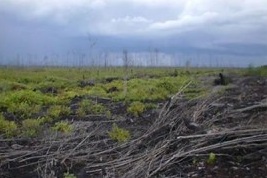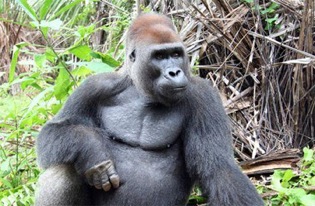 Along with Australia, the Indonesian government is hoping to turn a deforestation disaster in Borneo island into a global lesson on how to help locals save tropical forests. And an 830,000-hectare tract of rainforest in Cameroon has been granted by the government a 30-day reprieve from logging following the discovery of large populations of lowland gorillas, forest elephants, mandrills, and chimpanzees.
Along with Australia, the Indonesian government is hoping to turn a deforestation disaster in Borneo island into a global lesson on how to help locals save tropical forests. And an 830,000-hectare tract of rainforest in Cameroon has been granted by the government a 30-day reprieve from logging following the discovery of large populations of lowland gorillas, forest elephants, mandrills, and chimpanzees.REDD: Gaining Profit from Saving Borneo's Rainforest
by Elisheva Wiriaatmadja

CARE Indonesia is one of the many organizations helping the Indonesian government to preserve and rehabilitate 100k Ha of carbon-rich peat land in Central Kalimantan. Another organization Greenline Care Indonesia is also in the efforts of restoring 183k Ha of rainforest in East Kalimantan. There is a potential revenue from carbon offset of billions of dollars annually in the near future through saving the forest. However, the greatest challenge would be to change the behavior of the community to support the fight against deforestation.
Half of the forest in Central Borneo has been cleared while the other half still forested but is under threat. However, this represents only a fraction of an area of forest that was cleared in the 1990's by the orders of former President Suharto. He mistakenly hoped of growing vast crops of rice on Borneo which is mostly peat land. At the time, about 1 million hectares of forest were cleared. The majority of this land is sitting on carbon-rich peat swamps.
Peat forest as found in Central Borneo soak up vast amount of CO2 (carbon dioxide) locking away carbon in the wood and soil. Every year, 1 Ha of peat soil releases 2,000 tonnes of CO2 as well as large amounts of methane which is a more powerful greenhouse gas than Co2.
In the meanwhile, despite the disaster the carbon industry sees a great opportunity in the vast amount of carbon locked away in the peat soils. By stopping the peat land from burning and doing replanting on the bare land carbon traders sell carbon offset, which is the balance of reduced carbon amounts through deforestation prevention.
There are now many green companies interested in a project that aims to use carbon credits from saving forests to reward developing nations. This project is called Reduced Emissions from Deforestation and Degradation (REDD). Projects like these are tightly backed up by the United Nations and it is hoped that REDD will become a broader climate pact and ready by 2012.
Partners of IndonesiaToGo.com are currently searching for interested greenline investors to invest in for-profit reforestation program in East Kalimantan. If you are an investor or know people who would be interested to profit from saving the forest, contact IndonesiaToGo.com. Original article on IndonesiaToGo.com
Cameroon rainforest given 30 days to be conserved or sold off for logging
Rhett A. Butler, mongabay.com
June 18, 2009
An 830,000-hectare tract of rainforest in Cameroon has been granted a 30-day reprieve from logging following a 4-week exploratory expedition that turned up large populations of lowland gorillas, forest elephants, mandrills, and chimpanzees, according to expedition leader Mike Korchinsky, founder of the conservation group Wildlife Works.
The Cameroonian government has given Wildlife Works, which pioneered the first forest-based carbon project in Kenya, 30 days to come up with a competitive proposal to logging. The group is now scrambling to secure necessary funding to finance the early stages of the project.

"We have buy in from the local community, including Baka pygmies who depend on this forest," Korchinsky told mongabay.com. "This is a beautiful rainforest that houses a lot of wildlife and stores a lot of carbon. It provides important services to the 10,000 or so people who live in the area and losing it to loggers would leave them a lot poorer."
Ngoyla-Mintom borders the Republic of Congo and serves as a corridor of habitat between three national parks in Cameroon, Gabon and Republic of Congo. Conservation groups managed to hold off logging in the area for nearly a decade but failed to deliver on promises to develop ecotourism and sustainable industries. Facing a credit crunch from falling commodity prices, the Cameroon government last year said it would divide Ngoyla-Mintom into 9 blocks to be sold off to loggers. The subsidiary of an Australian mining firm, Cam Iron, recently signed a deal to mine iron southeast of the area.
Wildlife Works aims to eventually finance the project by selling forest carbon credits in the voluntary carbon market. Credits would be generated by avoiding deforestation that would otherwise occur if the forest were logged. Korchinsky estimates the project could avoid 5 million tons of carbon dioxide emissions per year, a conservative figure given the amount of carbon stored in the dense forest vegetation--likely upwards of 300 tons per hectare.
"We have 30 days," said Korchinsky. "This is a race against time."
Mike Korchinsky
mike (*at*) wildlifeworks (*dot*) com
415 265 4744
wildlifeworks.com
Original article at: news.mongobay.com

